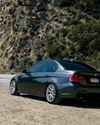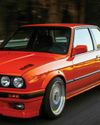Getting a grip with the wavetrac differential.

A performance car with an open differential is nothing out of the ordinary. Lotus even refused to equip the twin-turbo V-8-powered Esprit with anything but an open diff. Why? Limited-slip and locking differentials, while good at putting power to the ground, often make a car more difficult to rotate. Luckily, technology and design have come a long way, and now it is possible to get the straight-line grip you want from a limited-slip differential along with the nimbleness achieved with an open diff.
We wanted to test out the latest and greatest in limited-slip technology so we contacted WaveTrac, part of Autotech Driveline in Aliso Viejo, California, to check out its latest unit in a BMW 335i. First, let’s talk a little bit about the different types of differentials out there and then we’ll look at what’s involved with the install.
DIFFERENTIAL (DIFF)
Essentially, the differential is a set of gears powered by the engine and transmission (and in RWD and AWD vehicles, a driveshaft) that work together to turn the axles going out to the drive wheels. It allows the wheels to spin at different rates of speed, which is necessary if you want your car to turn without tire slip. For example, if you were to drive in a circle, the inside wheel drives less distance than the outside, so different wheel speeds are obviously necessary. There are three basic types of differentials: open, locked, and limited slip.
OPEN DIFF
This story is from the October 2016 edition of European Car.
Start your 7-day Magzter GOLD free trial to access thousands of curated premium stories, and 8,500+ magazines and newspapers.
Already a subscriber ? Sign In
This story is from the October 2016 edition of European Car.
Start your 7-day Magzter GOLD free trial to access thousands of curated premium stories, and 8,500+ magazines and newspapers.
Already a subscriber? Sign In

2017 Lamborghini Huracán 580-2 Spyder
Rear-wheel-drive, Open-air Drift Machine

Apotheosis
CEO Andy Palmer discusses Aston Martin’s rebirth.

Differential Tech
Getting a grip with the wavetrac differential.

2016 VW Passat Sel V6
Introduction—welcome to the Family Car.

Simply The Best
H&R SPRING BUILDS WHAT MIGHT BE THE FINEST E30 ON THE PLANET.

Flying Beetle
RIDING ALONG WITH TANNER FOUST IN VWÕS 550HP GRC BEETLE

2018 Jaguar XJR575
2018 Jaguar XJR575

Living History
JAGUAR CLASSIC WORKS IN THE SHOP AND ON THE ROAD

Spanish Holiday
This New F-Type Is The First Mass-Produced Offering From Svr, And It’S Anything But Ordinary

2017 Porsche 911 Turbo
Not Just Faster Than Ever, Better Than Ever